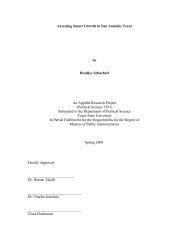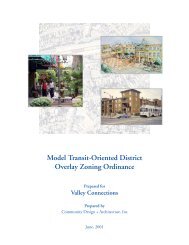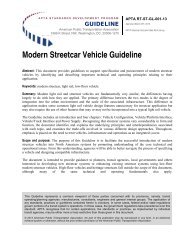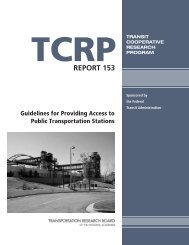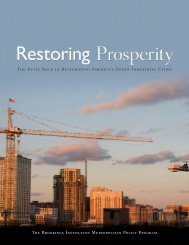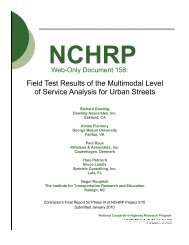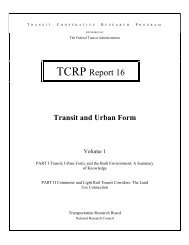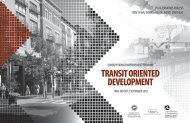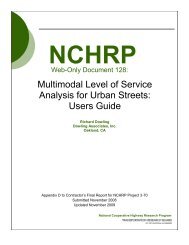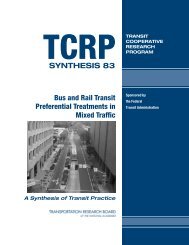Download the full report (PDF, 734 KB) - Reconnecting America
Download the full report (PDF, 734 KB) - Reconnecting America
Download the full report (PDF, 734 KB) - Reconnecting America
- No tags were found...
Create successful ePaper yourself
Turn your PDF publications into a flip-book with our unique Google optimized e-Paper software.
Transit-Oriented Development in <strong>the</strong> States• A property located within one-half mile radius surrounding <strong>the</strong> midpoint of one of up to two underground lightrail stations’ platform areas that are closest to an interstate rail station; or• A property adjacent to, or connected by rail spur to, a freight rail line if <strong>the</strong> business uses that freight line forloading and unloading freight cars on trains.Note: Senate Bill 1562 of 2012 raised <strong>the</strong> total lifetime cap on <strong>the</strong> urban transit hub tax credit program by $250 million,from $1.5 billion to $1.75 billion, and extends <strong>the</strong> deadline for initial tax credit application submissions from Jan. 13,2013, to July 1, 2014, and for final tax credit application submissions from Jan. 12, 2016, to July 28, 2017. Since <strong>the</strong>creation of <strong>the</strong> Urban Transit Hub Tax Credit Program, 19 projects have been approved for a total benefit of more than$1 billion.N.J. Rev. Stat. §34:1B-209.2 and §34:1B-209.3This law defines a qualified residential project as any building, complex of buildings or structural components of buildingsconsisting predominantly of residential units, located in an urban transit hub within an eligible municipality. Adeveloper, upon application to and approval from <strong>the</strong> authority, shall be allowed a credit of up to 35 percent of its capitalinvestment in a qualified residential project.N.J. Rev. Stat. §52:27D-489cThis law defines a Transit Village as a community with a bus, train, light rail or ferry station that has developed a planto achieve its economic development and revitalization goals and has been designated by <strong>the</strong> New Jersey Department ofTransportation as a transit village.Note: Urban Transit Hubs and Transit Villages are exempt from <strong>the</strong> imposition of a nonresidential development fee.There are currently 26 designated Transit Villages.New MexicoN.M. Rev. Stat. §5-15-5As part of <strong>the</strong> Tax Increment for Development Act to provide tax financing for public infrastructure, <strong>the</strong> law requiresa tax increment development plan to include a description of innovative planning techniques, including mixed-usetransit-oriented development, traditional neighborhood design or sustainable development techniques, that are deemedby <strong>the</strong> governing body to be beneficial and that will be incorporated into <strong>the</strong> tax increment development project.New YorkN.Y. Environmental Conservation Law §6-0103 and §6-0107“Municipal centers” are defined as areas of concentrated and mixed land uses that serve as centers for various activities,including, but not limited to, transit-oriented development.Among o<strong>the</strong>r provisions, <strong>the</strong> State Smart Growth Public Infrastructure Policy Act prohibits a state agency from financinga public infrastructure project unless it is consistent with state smart growth public infrastructure criteria. These criteriainclude, among o<strong>the</strong>r things, fostering mixed land uses and compact development, diversity and affordability of housingnear places of employment, recreation and commercial development, and integration of all income and age groups;advancing projects for <strong>the</strong> use, maintenance or improvement of existing infrastructure; and providing mobility throughtransportation choices, including improved public transportation and reduced automobile dependency. The chief executiveofficer of a state infrastructure agency shall attest in a written smart growth impact statement that <strong>the</strong> project, to <strong>the</strong>extent practicable, meets <strong>the</strong> relevant criteria. If compliance with <strong>the</strong>se criteria is considered impracticable, <strong>the</strong> agencymust prepare a statement of justification.National Conference of State Legislatures | 22



